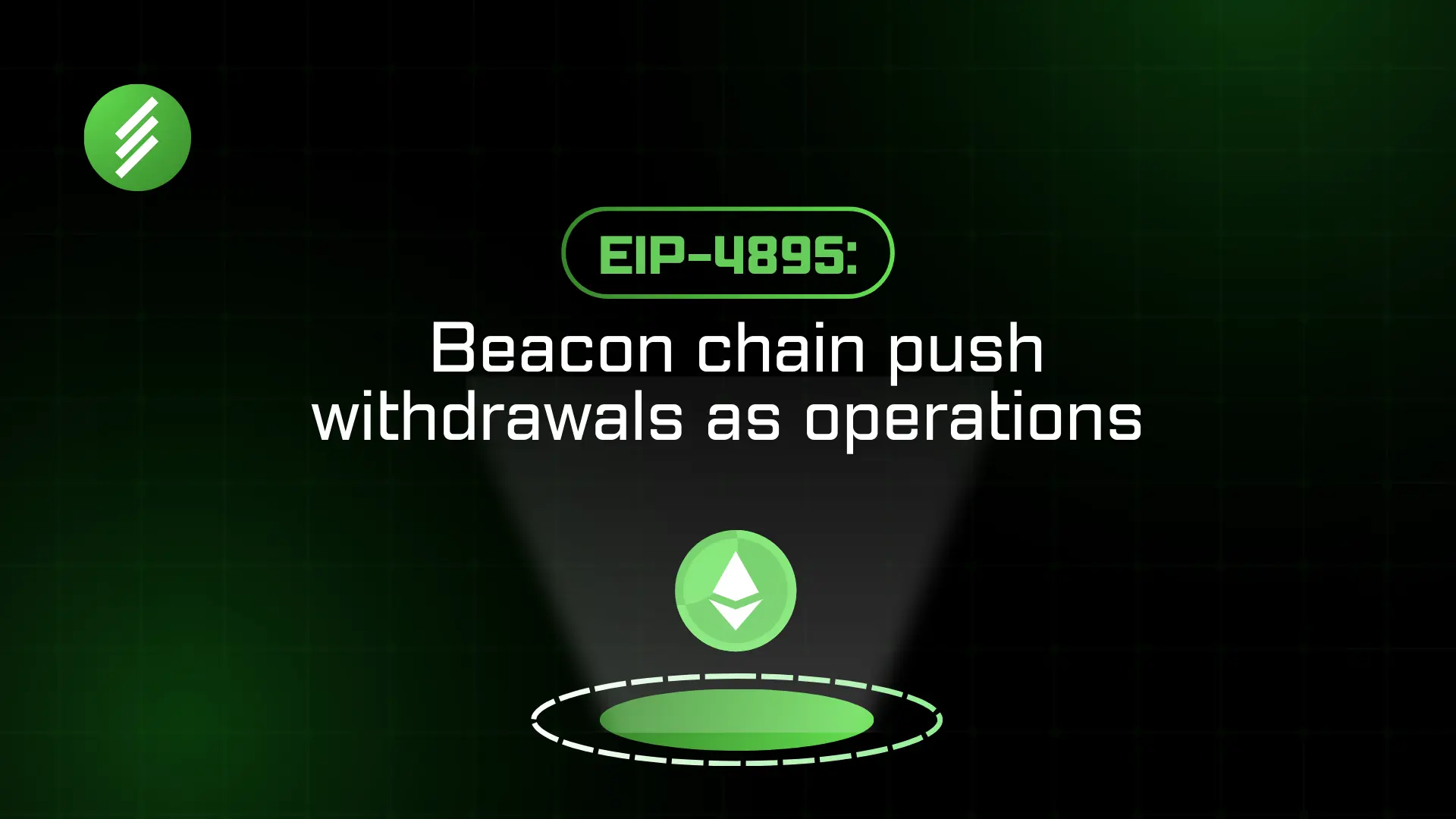EIP-4895
Written by: Wisdom

EIP-4895 is a proposal that brought about a new dimension on how validators on the beacon chain are able to withdraw their staked ETH to the main Ethereum Virtual Machine. This proposal made it for withdrawals to happen without requesting for withdrawal. This article will discuss EIP-4895 deeply and it’s improvements to the Ethereum ecosystem.
Definition
EIP-4895 is a proposal whereby system level “operation” are supported to allow validators to withdraw their staked ETH on the beacon chain to the Ethereum Virtual Machine. The architecture this is being done through is called the “push” based architecture. This means that withdrawals are processed in the execution layer immediately once it is dequeued from the consensus layer. Here withdrawals are tagged a new label “ operation “ that makes it easy to simplify testing, security, also it helps to separate system-level concern with data.
NOTE : The withdrawal feature being used in the push based architecture is different from withdrawals for user level transactions.
Importance of EIP-4895 to the Ethereum Ecosystem
EIP-4895 brought to the Ethereum ecosystem through the push based architecture :
- Integration : EIP-4895 has enabled the easy integration of staked funds withdrawn from the Beacon chain into the Ethereum mainnet.
- Cleaner Architecture : EIP-4895 separates the system level “operation” from the user-level transactions as this tends to make the system more organized. it will make it easier to understand and manage each transaction.
Brief history EIP-4895
The Ethereum Improvement Proposal, known as EIP-4895, was put forth by Alex Stokes and Danny Ryan on May 10th, 2022. This proposal falls under the ‘core’ category of EIPs. The main objective of EIP-4895 is to streamline the process of withdrawing from the beacon chain to the Ethereum Virtual Machine. By doing so, it aims to eliminate any unnecessary delays, thereby enhancing the user experience. It was introduced during the Ethereum Shanghai Fork as EIP-4895 will bring about blockchain security and efficiency.
Development and Rationale behind EIP-4895
The rationale behind the EIP-4895 was to make withdrawals less complex, secure and efficient. EIP-4895 represents a critical step in the evolution of Ethereum, addressing the need for a robust and efficient withdrawal. Key considerations that took place in this proposal is :
-
Security : By isolating withdrawal operations, It will be much easier for testing to be done on each transactions to confirm if its malicious or a fake transaction (withdrawal in this case).
-
Efficiency: Given the way EIP-4895 was proposed, it made it easier to separate validators withdrawals from “ system-level “ transactions.
Technical Overview of EIP-4895
EIP-4895 stands as a pivotal moment and upgrade in the evolution of withdrawal in the Ethereum ecosystem through the “push” based architecture. This technical overview delves into the details of this upgrade. Let’s look at the key features and upgrade of the EIP-4895 :
-
Push Based Architecture : The push based architecture in EIP-4895 introduces a new concept whereby withdrawals are processed in the execution layer as soon as they are dequeued from the consensus layer. This in turn makes the transactions to be quite fast as opposed to the “pull based architecture”, In the push based architecture, withdrawal transactions are labelled as “ operations” to differentiate it from the user level withdrawal transactions, This makes the system to be well organized and simplifies testing by reducing the interaction with the user level transactions and therefore labels the withdrawal transactions as “ system-level” transactions.
Although this increases the complexity of the architecture of the withdrawal transaction when compared to the “pull” based architecture where transactions are handled upon request and this require constant management of the core protocol, The complexity comes in because for withdrawals to be processed once dequeued from the consensus layer it need to coordinate well with execution layer. As a downside of it increasing complexity, It made it easier for tighter integration as the core protocol takes the “system-level” transactions as important.
-
Separations of Transactions : The EIP-4895 separates the transaction into two part which are; User level transactions and System level transactions. By this method of separation, this makes the transaction data to be separate and not mix with one another. More so, it brings about more security and organization to the system.
-
Introduction of a new object to the System Level operation : The new payload object which was introduced is called
withdrawalas it represents all the withdrawals confirmed at the consensus layer and it is similar to a user-level transaction but does not live on the same domain as the user-level transactions. -
Introduction of new execution payload header : The new execution payload header that was added was the
withdrawal_rootheader, it is meant to commitwithdrawalsto the payload header.
NOTE: The withdrawals in an execution payload are processed after any user-level transactions are applied.
Advantages of EIP-4895
EIP-4895 has lots of advantages to the Ethereum ecosystem ranging from :
- Clean Architecture
- Security
- Tighter Integration.
Potential Challenges and Limitations
While EIP-4895 has its advantages, it’s important to understand that it also has challenges and limitations. These include:
- Complexity : The complexity of the way the “ push based architecture” works will pose a great difficulty to the validator withdrawal system if not implemented well.
- Consensus layer validation for ETH withdrawal transaction is important to ensure that the right amount of ETH was withdrawn to the execution layer.
Future Improvements.
At the time of writing this wiki, there has been no new information on whether there will be an upgrade to EIP-4895. We will be sure to keep this wiki updated.
Conclusion
In conclusion, EIP-4895 marks a significant milestone in the evolution of Ethereum, offering a more efficient and secure mechanism for validator withdrawals. Its implementation reflects the Ethereum community’s commitment to innovation and continuous improvement, setting a precedent for future enhancements to the network.